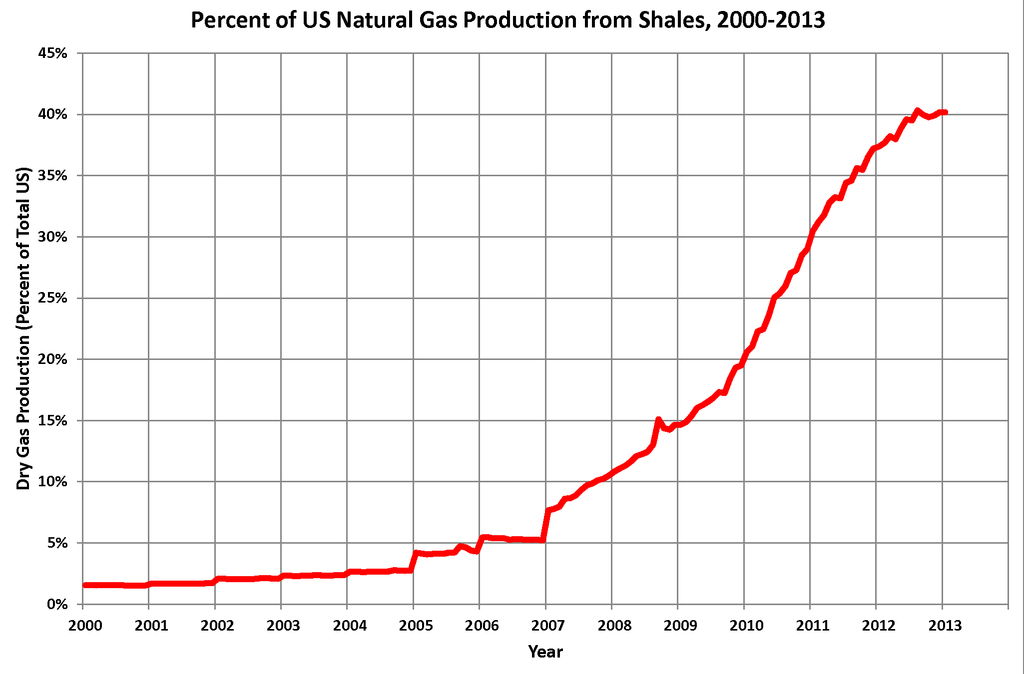Some Background
First: I used to be part of a team that was trying to improve the Sakhalin II oil and gas project, Russia's first off-shore oil/gas project, by putting pressure on the banks funding the project. We were able to get some improvements to the project site locations (away from critical feeding ground for Western Pacific Grey Whales) and get some concessions for indigenous groups whose reindeer-herding livelihoods were interrupted by the project.
 |
| Percent of Total U.S. Natural Gas Production from Shale 2000-2013. US EIA (2013) |
The Dakota Access Pipeline, when completed in 2016 or 2017, will carry oil from the North Dakota Bakken shale deposit to Illinois, a 1172-mile (1886-km) leg of a larger oil pipeline destined for Louisiana. (Source)
 |
| The dotted red line, representing a pipeline, is labeled "Bakken" in this 2015 Sunoco Logistics asset map. (Source, p. 3) |
The ACE approved the Dakota Access Pipeline permits July 25, 2016, and the Standing Rock Sioux Tribe filed a lawsuit against the ACE on July 27, 2016. On August 22, 2016, tribal members and allies began blocking the pipeline, creating a camp to support the blockade. (Source) On Aug. 23, 2016, this photo appeared on the front of the New York Times, bringing international attention to the blockade:
 |
| Photo by Daniella Zalcman. Published August 23, 2016, NYT |
The camp, called a prayer camp by supporters and an illegal act of trespassing by Dakota Access, LLC, began to experience escalating acts of violence by armed private security forces, police from multiple states and agencies, and the U.S. National Guard. These forces have been documented using weapons such as attack dogs, mace, rubber bullets, concussion grenades, and tasers on adults and children alike. Journalists covering the violence have been arrested, and in one case charged with rioting (rejected by a judge, Oct. 17, 2016). Currently camp residents are digging in for the winter.
Where do the banks come in?
Texas-based Energy Transfer Partners, the parent company of Dakota Access, LLC, has put together a network of financial deals to support construction of the Dakken pipeline from North Dakota to Louisiana. The three main entities involved, called the Energy Transfer Family, has both direct loans and revolving credit from 38 banks. See the graphic below for which banks are supporting which part of the project: there is revolving credit extended to Sunoco Logistics, Energy Transfer Partners, and Energy Transfer Equity, and direct project loans to Dakota Access, LLC. In response to this research Yes Magazine published contact information for the 38 banks involved (see their list of Banks and addresses, Sept. 29, 2016).
 |
| Food and Water Watch produced this graphic with information from Rainforest Action Network's access to Bloomberg Terminal. (Source, Sept. 6, 2016) |
There are 85 financial institutions signed on to the Equator Principles at this time (according to the EP Association website). 23 are involved in supporting the Dakota Access Pipeline with 13 of those giving direct loans, an act which should trigger the EP guidelines on project finance.
When I went to my old bank-watchdog friends to ask for the environmental compliance desk contact information for the EPFI's involved in supporting the Dakota Access Pipeline, they realized that the annual meeting of the Equator Principles Association is in London this coming Tuesday, Nov. 8th, an excellent opportunity to address the association as a whole about the pipeline. A letter titled "Open letter to the Equator Principles annual meeting on Dakota pipeline and climate commitments" is now circulating among bank-watchdog organizations, accruing signatories before being delivered on Tuesday.
Here are the two key paragraphs outlining the letter's demands (DAPL = Dakota Access Pipeline):
We understand that it is not the role of the EP Association to intervene in specific project situations. Nevertheless, we consider it crucial for the credibility of the Equator Principles as an effective safeguard against violation of Indigenous Peoples’ rights that your meeting calls upon the EPFIs involved in financing DAPL that they take swift action to stop the ongoing violation of the rights of Native Americans.
This for now requires that all further loan disbursements to the project are put on hold, and that the EPFIs involved demand from the project sponsors an immediate halt to the construction of the pipeline and all associated structures, until all outstanding issues are resolved to the full satisfaction of the Standing Rock Sioux Tribe.
The letter is intended to be in solidarity with the leadership of the Standing Rock camp; in the absence of official camp leadership, efforts were made to align these demands with those of the Standing Rock Tribal Council.
I hope this does some good.
P.S. Monday morning update: read the full final letter that was just sent to the EP Association.
P.P.S. Tuesday morning update: read the New York Times coverage of the letter.





